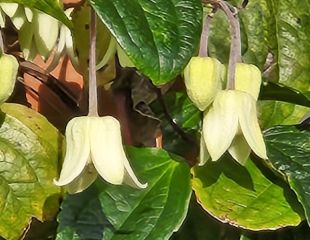


Winter flowering Clematis
If you are looking for winter colour and interest in the garden there are several late autumn, and winter flowering Clematis .
One of the most commonly grown is Clematis cirrhosa illustrated below. Other varieties of C. cirrhosa are 'Christmas Surprise', 'Jingle Bells' both of which flower November onwards and have limey cream flowers. Another popular variety is C.cirrhosa 'Wisely Cream' flowering late from January to March and hardy to -10c.
C. armandii requires winter protection and Clematis cirrhosa var. balearica which is hardier H4, but may not survive a severe winter without protection.
There is also Clematis urophylla 'Winter Beauty' (centre left) which is evergreen, scented and H3 hardy with small creamy white bell-shaped flowers.
Flowering in late winter and early spring are C. alpina and macropetala and the very popular also is Clematis armandii, illustrated below, an attractive Clematis when grown in the right place noting that it is also H4 hardy.
See also Winter flowering evergreen Clematis for more ideas.
Suttons have a range of autumn and winter flowering clematis, including C. Winter beauty, armandii, cirrhosa Freckles,
Clematis armandii

C. Armandii is evergreen or semi-evergreen. It has glossy leaves and many varieties have scented flowers. Grown in the right spot, sheltered away from cold winds, it looks fantastic. But only in the right spot which is why I have included the image on the right to show the results when grown in an exposed position.


Clematis cirrhosa Freckles,
This variety is C. cirrohosa 'Freckles'. It is evergreen, scented and long flowering. It is H4 hardy and like many of the early Clematis it grows best when planted in a sheltered spot.
Like all Clematis, it should always be planted slightly below soil level. For more advice, see how to plant Clematis and video help.

All these Clematis are Group 1 which means they do not require annual pruning, but they can be tricky because some are not fully hardy. This means planting in the right place is critical to maintain the health of the plant. Because of these difficulties, I have tagged them amber wheelbarrow. Medium difficultly to grow.
If you feel that frost and cold maybe a problem, it may be better to pick a Clematis. alpina or macropetala. Although both groups flower slightly later, in early spring, they are more hardy H6 making them easy to grow and still no pruning.
